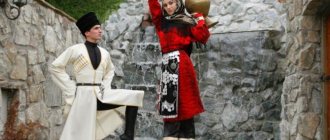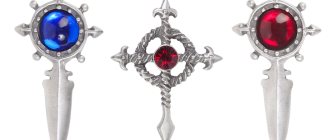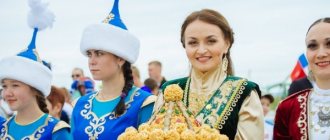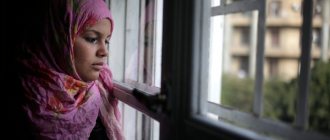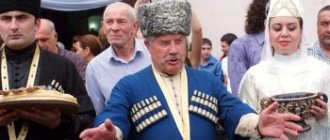Dagestan is a republic of Russia, which is located in the southernmost region of the country. In addition, it is multinational and unites 102 nationalities. Among them are both indigenous and visiting populations. Indigenous nationalities include Avars, Aguls, Andians, Kubachi, Dargins, Laks, Rutuls, Lezgins, Tabasarans, Tsez and others.
The culture and traditions of the peoples of Dagestan are very diverse; they were formed over many years and passed on from generation to generation. Each of these peoples has its own characteristics and differences that give them their identity.
Avars
Maarulal or Avars are the people of Dagestan, numbering about 577 thousand people. They are distributed throughout western Dagestan, especially in the mountainous regions. Most of them are rural residents. They communicate in their Avar language, which has many dialects. The Avars profess Islam, but elements of paganism are still present in their faith. They have a sacred attitude towards nature, honor it and call for help by performing magical rituals.
The traditional occupations for these people are cattle breeding and farming. The preferred animals are cattle, and in the mountains - sheep. The Avars developed a highly organized structure of terrace farming, which in the mountains was supplemented by an irrigation system. Like the rest of the peoples of Dagestan, the Avars have been actively using home crafts for a long time. These include weaving, embroidery, wool knitting, wood and stone carving, and blacksmithing.
“Customs and traditions of the Dagestan people”
Temaeva Madina
“Customs and traditions of the Dagestan people”
Traditions and customs of the Dargins
The wedding rituals of the Dargins included obtaining consent for marriage, matchmaking, conspiracy, betrothal, and staying in “another house.” The rituals of introducing a newlywed to a new family and household included: entry into the common family room, the first trip to get water from a rural spring, and returning home.
In the upbringing of children, an important place was occupied by accustoming them from an early age to the activities of adults: a boy is a future warrior, a girl is a future housewife-mother. A coming-of-age celebration was celebrated, during which, according to custom, the young man was girded with a dagger, and the girl put on her “grandmother’s adult jewelry” stored in a chest.
Most solemnly, the Dargins celebrated the holiday of the first furrow, which marked the beginning of a new agricultural year and was celebrated in the spring, at the time of the awakening of nature. Before this holiday, no one had the right to go out to plow, and those who violated tradition paid a fine. The basis of the celebration is the ritual plowing of the field. Magic techniques occupied an important place in the ritual. The luckiest, most respected person was chosen as the chief plowman so that the harvest would be plentiful. He wore a fur coat turned inside out, which expressed the wish for a rich harvest: “As the wool of a fur coat is thick, let the harvest grow just as thick.” The plowman was doused with water to prevent drought.
The spring holiday is traditional, which is still celebrated very colorfully in the village of Kubachi. The main participants in the celebration are young people. On this holiday, young men look for brides for themselves.
Girls prepare especially carefully for the holiday, sewing new dresses and embroidering white bedspreads. An important condition for participation in the holiday is the well-being of the village families. In case of misfortune in any family, they do not go out for the holiday. Weather conditions also play a significant role. If the weather is foggy or rainy, the holiday is postponed.
The celebration begins early in the morning. The signal for the beginning of the holiday is a red scarf, which is lined on the mountain located opposite the village. The young men announce the beginning of the celebration with gunshots. The main goal of the participants is to reach the distant spring. The girls take copper jugs with them, polished to a shine, to bring spring water home. People are dancing at the source, young people are picking flowers. One of the most solemn moments is the return of the youth and meeting with the village residents. Joint dances are held here.
The ritual holiday of the fortieth day of spring was once associated with the solemn procession of residents to the source for water “from the evil eye.” They brought it home for the elderly and sick. People wanted to join the miraculous, magical power of water, which, in their opinion, especially intensified during the spring awakening of nature.
One of the oldest was the harvest festival, coinciding with the end of field work. The basis of the celebration is a joint meal, after which dancing and games are organized. Dargin folklore is rich in traditions, legends, fairy tales, proverbs and sayings, heroic songs and ballads.
Dargin weddings
- not only fun, but also a tribute to our ancestors. Immediately after the registry office, the young people visit the mosque, and then come to their parents’ house with a bow and words of gratitude. Previously, Dargin weddings were celebrated in such a way that women and men sat at different tables. Today, not everyone follows this tradition. After all the required rituals have been completed, the usual modern fun begins.
Signs and superstitions for a wedding
. Dargins believe that the more people honor the newlyweds with their presence at the wedding, the more complete their wealth will be and the happier their family life. Men dancing with the bride must shower her with gold: this is how they wish happiness to the new family.
Kumyk customs and traditions
One of the most joyful events was the birth of children. Having many children was considered a sign of family well-being. The birth of boys was celebrated especially solemnly. Even before birth, the mother-in-law prepared clothes, diapers, and a cradle for the baby. It was believed that it was very easy to “spoil” a woman in labor and a newborn, so strangers were not allowed into the room where she was. The main enemy of women in labor was considered to be an evil spirit - a woman of enormous height with flowing hair. Therefore, during childbirth, all windows and doors were closed in the room where the woman in labor was. The birth of a child was first reported to the mother-in-law, then to other family members. The woman was fed a special meal made from wheat flour with honey and grapes. It was customary to remove the hat from the head of the newborn's father, which he was obliged to buy. Relatives and neighbors came to congratulate the family on the birth of their child. A week after birth, the baby was placed in a cradle and given a name. Only women were present at this ceremony. A bowl of flour was placed in the cradle as a wish for the baby to live to a ripe old age, when his hair would become white as flour. The name was chosen at a family council. Usually the baby was named after a deceased relative or kunak. Grandma said the name first. Until a certain age of children, fathers did not take part in their upbringing, and it was not customary to show their parental feelings. Even the mother was not supposed to caress her children in front of strangers.
Lezgin customs and traditions
Honoring Elders
It was customary to judge the degree of a person’s upbringing in Lezgin society primarily by his attitude towards elders; a well-mannered person treated them with great respect and consideration. At the same time, high respect for elders was expressed regardless of his social status or nationality.
The norms of people's behavior towards their elders indicate a high level of mass culture of the people. This value system, created by the collective mind of our ancestors, which the current generation cannot but cherish. These good traditions are now observed by those who, being completely modern people, have at the same time preserved the good traditions of the past, distinguishing them from their environment and making them pleasant and desirable in society.
The most important form of showing respect for elders among Lezgins is greeting. When meeting a Lezgin, especially an older one, you should definitely greet him first. Every self-respecting Lezgin considered himself obliged to stand up when an elder appeared, regardless of whether he knew him or not. Etiquette required standing up, giving up your seat to the elder and not sitting down until then; until the person whose appearance was honored by standing up, in turn, asks everyone who has risen from their seats not to bother themselves and to sit down in their places. No matter how the youngest person is asked, he should not sit before the eldest person present. “They will beg you, forcefully imprison you, but the trouble is if you give in: you will be considered ignorant. Therefore, you must make excuses and stand respectfully. Etiquette did not allow sitting next to the elder, but a little further away, preferably on a more distant and lower bench. The young man never allowed himself to keep his hands in his pocket in the presence of his elders, sit waddling with his legs apart, or cross his legs, in a word, he chose the most modest pose.
In the presence of an elder, the younger ones should have listened to him in silence, they should not have started a conversation before him, inserted their word into the conversation of the elders, interrupted the speech of the elder, be verbose, or drink too much.
Etiquette did not allow the elder to cross the road or enter the room before him. The order of seniority was observed not only at home, but also on the road. When a younger person rides with an older one, he must definitely stay on the left side. If there are three travelers, then they walk in this order: the eldest goes in the middle, the middle one on the left side, and the youngest on the right. The eldest was given fire if he smoked; They didn’t ask their elders for a light and generally didn’t smoke in front of them. When the elder made a speech or a toast at the table, the younger ones listened to him standing and in absolute
silence. The slightest desire of the elder should have been predicted and warned, served to him: the younger knew his place in society, on the road. Any disrespect for elders was condemned by public opinion and was considered shameful, degrading a person’s dignity. In front of elders, it was not customary to talk about love, about women, about their children. Obscene and obscene words were completely excluded.
Our ancestors were distinguished by longevity
The main reason was that our old people did not feel like extra people or a burden either at home or in society, but on the contrary, they were fully aware of their usefulness, which contributed to their moral and physical stamina and endurance. Such care and attention instilled confidence in them and contributed to longevity.
The elders supervised labor processes, acted as guarantors and co-jurors in people's courts, and consultants on wedding and funeral rites; They also said prayers on national holidays. They lived an active life. Until the end of their days they remained the heads of their family groups and consulted with them. In general, the elder enjoyed unquestioned authority.
Even if what the elder said was wrong, no one allowed themselves to abruptly interrupt him. In most cases, the life experience and knowledge of the elder often not only did not contradict, but, on the contrary, contributed to the upbringing of a spiritually healthy generation. The neglect of some young people for the opinions and advice of their elders, the thoughtless imitation of a falsely understood Europeanized culture and innovations have not brought us anything good, and more than enough harm.
As life practice has shown, love and respect for children for their fathers, for people of the older generation, is one of the best etiquette norms of the Lezgin people. The younger one is obliged to show the older one respect, attention and help. The most honorable places at the table, the most honorable parts of meat, were given to the elders, and first of all, toasts were raised to their health. For his part, the elder, in relation to the young, had to behave extremely correctly, tactfully, and not abuse his position as an elder.
The elder, wise with experience, well understood his rights and obligations, respected by the centuries-old tradition, tried to comply with them, made efforts not to become decrepit prematurely, to keep himself on the level, to be neat and smart. The relations of the elder to the younger, and vice versa, the younger to the elder, were regulated by customary law, which both parties observed very strictly.
At the present time, when our society has turned its face to national culture, the revival of time-tested norms of behavior associated with respect for elders is a matter of paramount importance
Birth of a child
The birth of a child, especially the first-born, was considered a big event in the families of the Lezgin group of peoples. The birth of him, especially a boy, somewhat freed the woman from heavy responsibilities and gave her noticeable rights. In honor of the birth of his son, a big feast was held, in which all the relatives took part, who expressed wishes that in the future “he would have many children, live a long time and become an old man.” At birth, the girls wanted her to be happy,
became a grandmother, but to be the last.
During pregnancy, the woman did not use special care and continued to lead a normal lifestyle until the birth, freed only from hard physical work. Her wish was willingly fulfilled. In superstitious families, “haikly” talismans—amulets—were sewn onto pregnant women’s clothes. The birth took place in a room, on an earthen floor, in the most primitive surroundings.
During childbirth, she was helped by “genechi” (in Lezgin, “gana-bab” (in Tabasaran) - a midwife. Part of the population believed that a pregnant woman was surrounded by strings of evil spirits trying to destroy her. Being powerless to help the woman in labor real help, midwives in difficult cases resorted to various kinds of magical means. They hung “haikels” (amulets) in the room of the woman in labor, untied a broom, hoping with these techniques to expel evil forces, the Lezgins believed in the existence of the evil spirit “Al-pub”, which , supposedly, brought suffering to the woman in labor. During difficult births, they fired from a gun. The birth of a boy was considered a big event in the life of the family and all relatives. The newborn was washed, swaddled, and only after that was placed with the mother. After giving birth, the woman in labor was fed special ritual food “heshil”, and also halva. All the relatives and neighbors came to visit the woman in labor and the child. They brought food and gifts with them. According to custom, when the wife gave birth, the husband left home. At the birth of a boy, a relative or villager hurried to please the child’s father. The first one who managed to inform the father about the birth of his son received money or even a whole ram from him. In honor of their newborn first-born son, parents distributed gifts to the most respected relatives, and three days later they prepared national dishes and treated the guests. The grandmother-midwife who delivered the birth was also invited to the celebration, who was given gifts, and the relatives of the newborn tried to maintain good relations with her. For the first few days, the child lay in his mother's bed. When the mother got up and got to work, the child was swaddled and placed on his back in a special children's national cradle “kyeb”. “Haikels” (amulets) against the “evil eye” were hung from the cradle, a knife, scissors, etc. were placed under the pillow.
Chechen customs and traditions
In the family circle
«Attitude towards elders
" The unshakable rule of every Chechen family is respect and care for the older generation, especially parents.
Usually parents live with one of their sons. In the morning, the good daughter-in-law begins her housework in half of the old people. Only after that does she start other things. Sons, returning home in the evening, first of all go to their parents to talk with them, share their joys and worries.
Not only the son and daughter, but also other family members, including grandchildren, take care of the elderly. In Chechen, grandfather is called “big father,” and grandmother is most often called “mother.” Children can sometimes disobey, not fulfill the request of their father or mother, and they will be forgiven for this. But it is completely unacceptable to disobey your grandfather, grandmother, other older relatives or neighbors. Not standing up when old people appear or sitting down without their persistent invitation means demonstrating poor upbringing. Tradition does not allow drinking alcohol in the presence of parents or any older relatives. You should also not speak to elders in a raised tone or behave cheekily.
If the parents do not live with one of the sons, then the children are especially attentive to them: for example, the best products are constantly sent to the parents’ house. In rural areas, as a rule, a separate house is placed in the yard for the elderly. This is a long-standing custom: there the elders in the family are provided with the most comfortable living conditions that correspond to their needs and age.
«Related responsibilities
" Most Chechen families have many children. In addition, several brothers often live with their families in the same yard or in the same village. Over the centuries, the rules of family relationships have evolved. In general terms, they are like this.
Conflict situations, quarrels between women, children, and the like are resolved by the eldest man or woman in the yard.
The mother of children, if they were offended, should never complain to her husband. As a last resort, she can turn to any relative of her husband. Although it is considered a rule of good manners not to pay attention at all to children's grievances, quarrels, and tears.
Chechen children know that it is their uncle who will readily respond to any of their requests and help. He would rather deny something to his child, but without very serious reasons he would never leave the request of the children of his brothers and sisters unanswered.
The rules of family relationships presuppose the responsibilities of the younger ones to the older ones, and vice versa. The older generation is responsible for strengthening family ties. Parents must maintain an atmosphere of harmony and mutual understanding in their sons' families. In this case, special correctness is required in relation to the daughter-in-law. Thus, the father-in-law must be extremely delicate towards the wives of his sons: in their presence one cannot drink alcohol, swear, or violate the dress code accepted in the Chechen family.
«Family honor
" It is customary among Chechens to attribute both the merits and demerits of an individual to the account of his entire family. An unseemly act will cause many relatives to “blacken their faces” and “hang their heads.” And about worthy behavior they usually say: “Nothing else could be expected from the people of this family” or: “The son of such a father could not have acted differently.”
By raising children in the spirit of family traditions, Chechens instill in them the quality of “yakh”, which has the meaning of healthy competition - in the sense of “being the best.” The elders’ instructions sound something like this: “You must have yah. Under no circumstances should you be worse than your comrades. Don’t offend the weak, no matter who he is, and don’t be the first to offend anyone.”
Agultsy
The Agul people of Dagestan live in its southern part. The size of this population is approximately 8-9 thousand people. To communicate, they use the Agul language, which is related to Lezgin. This nation lives in 21 settlements in southeastern Dagestan.
The traditions of this people, like the traditions of the peoples of Dagestan in general, are unique. For centuries, the main occupation for the Agul people was cattle breeding. Only men had the right to care for sheep. Women worked exclusively with cattle.
Metal processing was a very important aspect of the life of the Agul people. Blacksmiths made axes, scythes, knives and sickles, which were useful in any household. The Agul people were excellent builders. They built bridges, houses and mosques. They decorated their buildings with skillfully carved stones, the ornaments of which reflected the entire culture of the peoples of Dagestan.
Andean group of peoples
The Andians are a whole group of nationalities, which includes such peoples of Dagestan as the Akhvakhs, Botlikhs, Tindals, Bagulals, Karatins, Godoberins, Chmalals and, in fact, the Andians themselves. The total number of people of these nationalities is 55-60 thousand people. They live in the highlands of Western Dagestan. Communication takes place in the Andean language with many dialects.
The religion of the Andians reflects the customs of the peoples of Dagestan, since the majority of the indigenous population are Sunni Muslims. Their main occupations were also agriculture and cattle breeding. Since ancient times, the houses of these peoples were built of stone. There were not many two-story dwellings; one-story ones were rectangular in shape. Those Andians who were engaged in agriculture developed their own agricultural calendar, which helped determine the time of sowing and harvesting certain plants.
Kunachestvo
It is customary to call a kunak a close friend or closest comrade among those present, but invariably connected with the owner of the house by close ties of long-standing friendship and shared events. Kunakism is a relatively late phenomenon, originating in the traditions of hospitality and the gradual weakening of blood and family ties in the realities of the modern world. If earlier residents of the settlement sometimes spent their entire lives in it, not counting the girl’s move to the groom’s house after marriage, now many Dagestanis leave their parents’ places for study, work, career or for other reasons.
The institution of kunakism became so firmly established in the life of the people that kunaks began to be passed down, as it were, by inheritance - from father or grandfather to son or grandson, from one descendant to another. Sometimes they were connected by newly acquired family ties, often the children of friends began to be friends, etc. However, it has always been considered correct to have Kunaks as close as possible in nationality or from other Caucasian peoples with whom the Dagestanis have developed good neighborly relations.
Dargins
Dargins are the people of Dagestan, traditionally inhabiting mountainous regions. There is no language that unites all Dargins; there are many variations of the Dargin language. The customs and traditions of the peoples of Dagestan, as well as the Dargins individually, are closely connected with the general social and economic processes that took place in the ancient period of history. They were engaged in the usual activities for the inhabitants of this territory, that is, cattle breeding, agriculture and folk crafts. The Dargins were famous for their jewelry, leather and wool products, and weapons. Women processed wool, wove cloth and rugs.
Customs of Dagestan related to kinship
Dagestan
Twinning
This custom has ancient roots. Usually, men who vow to become blood friends for the rest of their lives undergo the twinning ceremony. This ritual can be carried out in two ways: a verbal oath of loyalty to each other or mixing of blood. To do this, each of the men makes a wound on his body and drips blood into a container of water. After this, the drink is drunk by both parties. This mixture gave men strength, courage and courage.
In general, people who are united by some serious life situation resort to the custom of twinning. For example, war, joint exploits, providing assistance in a difficult situation. At first, such relationships develop into friendship, and only then into twinning.
people of Dagestan
Milk brotherhood
Dairy brotherhood is a fairly ancient and widespread tradition in Dagestan. Its essence lies in feeding the baby with the milk of a stepmother, who, in addition to her own child, feeds another one. Such children become brothers in milk. It is believed that milk is absorbed into the blood and distributed throughout the body. This is how children are related.
Breastfeeding with another woman's milk can be temporary, if the mother is away, or permanent.
Kubachi residents
These people of Dagestan live in the small village of Kubachi, Dakhadaevsky district. Their number does not exceed 1900 people. In addition, Kubachi residents also live in other settlements in Central Asia and the Caucasus. Their native language is Kubachi. The inhabitants of this settlement are mainly artisans. If they grew food or grazed livestock, it was of an auxiliary nature.
The most common crafts have long been metalworking, construction, wood and stone carving. Women were engaged in knitting, weaving, embroidery, and made felt from which they made shoes. Knowledge and skill in metal processing was passed on from father to son. Interesting are the folk dances of the Kubachi people, which were carefully developed for the performance of various rituals.
Large and small nations
Among the multinational peoples of Russia, Dagestanis are one of the most “variegated” in their composition. Actually, all the residents of the republic are representatives of different small nationalities, and such a nationality as the Dagestani simply does not exist. For example, the Avars, whose number is estimated at about a third of the total population of the republic, in turn unite about 15 more ethnic groups, and this is not the last division. The Tsakhurs are considered the smallest ethnic group here; today their number is no more than 10 thousand people, the main percentage of this population lives in Azerbaijan. The habitat of this small nation is the settlement of the same name Tsakhur in the high-mountainous Rutul region, which is considered the most inaccessible in the entire republic. The village was repeatedly burned to the ground at different times by numerous conquerors, but the hardworking and patient Tsakhurs each time restored it from the ashes and rebuilt their houses.
Laktsy
The central part of Nagorno-Dagestan is inhabited by another people - the Laks. Language – Lak, religion – Islam. This people have lived on the territory of Dagestan since ancient times. Their main occupation is growing wheat crops (rye, wheat, millet, legumes, barley, etc.). Livestock farming was also developed. Among the crafts, cloth making, jewelry making, pottery, stone processing, silver and gold embroidery were developed. The Laks were famous traders, confectioners and acrobats. This people is rich and epic. Stories about the great heroes of the past and how they fought evil were passed down from mouth to mouth.
New history of Dagestan
The participants of the press tour were lucky enough to meet with the most interesting people: Magomedali Magomedov - he led the region in the difficult year of 1999, and the militias who bore the brunt of the events of those years. The stories of that time are an example of courage, honor, love for one’s hearth, the Republic, and the country. One of the heroes, Magomed Isaev, captured two terrorists.
Magomedali Magomedov led the region in 1999. Photo: Elena BOGDANOVA
At the same time, participants in those events say that the most important thing for them is not even the material assessment of their activities from the federal authorities, but respectful attitude, the opportunity for their children to work honestly and conscientiously in their republic. For the participants in the events of 1999, the most important thing is respectful attitude and the opportunity for their children to work honestly and conscientiously. Photo: Elena BOGDANOVA
For the participants in the events of 1999, the most important thing is respectful attitude and the opportunity for their children to work honestly and conscientiously. Photo: Elena BOGDANOVA
Rasul Gamzatov said about people like them: “For centuries you taught everyone and me / To work and live not noisily, but boldly!”
The current head of Dagestan, Vladimir Vasiliev, met us in the park, and then answered questions from journalists over a cup of tea. He shared his successes, but did not hide his problems, and talked about the tasks facing the leadership of the republic.
The current head of Dagestan, Vladimir Vasiliev (left), told reporters about the tasks facing the leadership of the republic. Photo: press service of the head of the Republic of Dagestan
He once again emphasized that now, first of all, it is necessary to form an honest and professional team. That is why the winners of the “My Dagestan” competition have been appointed to key positions in the government of the republic. This competition for the formation of a personnel reserve was held by the government of Dagestan together with the administration of the President of Russia. 6 thousand people took part in it. 54 participants became winners. Half are already employed. The journalists were able to communicate with many, they are truly professionals, they set themselves ambitious goals: in a short time to make a breakthrough in many directions of the development of the republic.
In Dagestan, after several trials of mayors, there was a joke: “I’m looking for a job as mayor, I won’t offer Makhachkala.” New leaders appointed after winning the competition give hope that business in Dagestan will become transparent, taxes will remain in the region, and tourists will flock here.
It is better to see the beauty of Dagestan with your own eyes. Photo: Elena BOGDANOVA
I want to live in Dagestan! Perhaps that is why the republic occupies one of the first places in Russia in terms of life expectancy. Those who once left in search of a better life and achieved success are returning to the country. Now they have the opportunity to work for the benefit of their republic.
I advise everyone to visit this amazing region and see with their own eyes all the changes that have occurred in the republic in recent years.
Lezgins
The Lezgins settled compactly on the lands of Southern Dagestan. Their number in this area is 320 thousand people. Communication takes place in the Lezgin language, which is often modified by local residents. Lezgin mythology is rich in stories about gods who controlled nature. But paganism was replaced by Christianity, which after some time was replaced by Islam.
Like all the peoples of Dagestan, the Lezgins grew crops, especially wheat, rice and corn, and raised livestock. The Lezgins made wonderful carpets that are known far beyond their region. Weaving, spinning, felt and jewelry production were also common crafts. The Lezgins are also known for their folk dance - the Lezginka, which has become traditional for all the peoples of the Caucasus.
Day 1 furrow
In villages where residents are completely devoted to agriculture, the Day of the First Furrow is still celebrated. This is an ancient holiday, dating back to tsarist times. By the way, it is typical not only for the peoples of the Caucasus. Similar ceremonies took place in the culture of China and India.
On the day that spring field work begins, all residents of the village go outside. The beginning of sowing is a big event. In honor of him, traditional celebrations are held with songs, treats, and competitions.
First Furrow Ceremony. Before the process begins, prayer must take place. Then the head of the village or a respected person from the village must plow the first furrow. This action is considered more of a part of the ceremony. After all, on this day the fields do not continue to be plowed, as everyone proceeds to festivities.
Tabasarans
These people also live in Southern Dagestan. Their number is 90 thousand people. The Tabasaran language is divided into southern and northern dialects. The main belief is Islam. Occupations are also very traditional for this region - animal husbandry and agriculture. The Tabasarans are skilled in carpet weaving, pottery, blacksmithing, woodworking and making socks with a variety of patterns. Various genres of folklore, such as mythical tales and ritual songs, are quite developed.
Tsez group of peoples
The Tsez peoples include the Ginukhs, Bezhta, Tsez, Gunzib and Khvarshins. There is no common language; peoples communicate in their own dialects. For these peoples, the blood ties of families, the so-called tukhums, have long been of great importance. These associations helped each member and selected the most advantageous match for marriage. The products used were milk, dried and fresh meat, cereals, flour, fresh and dried fruits. Although these people profess Islam, beliefs in jinn, brownies, devils and witches have been preserved.
Thus, Dagestan is the cradle of many peoples. The culture and traditions of the peoples of Dagestan have retained their distinctive features in our time, which makes them interesting to study. Their faith combined the main features of Islam with remnants of the pagan past, which makes them unique.
Second day
Traditions of celebrating the second wedding day in Dagestan are already taking place in the groom’s house. On this day he comes for the bride and the newlyweds are escorted out of the house. When the young man comes for his chosen one, he is met by her sister, performing a traditional dance. The mother of the bride presents the newlyweds with a cup of honey, treating them. According to beliefs, such a ritual contributes to a long and happy life for the newlyweds.
On this day you can see many interesting rituals, competitions and competitions that well reveal all the skill of the Dagestanis. For example, most of them dance very well. The whole reason is that they are prepared for the wedding from early childhood, taught folk dances and songs.
Preparations for a wedding in Dagestan are structured in such a way that the entire celebration begins at noon. The bride is brought to the groom's house and here the real fun begins. Guys dance separately from girls, but this does not stop them from looking for a life partner.
The most important event at a wedding is the newlyweds' dance. But before it happens, the bride is obliged to dance with every man at the celebration. The young woman dances, and the man spins around her and throws banknotes, which are picked up by the bridesmaid. In Dagestan, it is not customary to give gifts; instead, they give money.
The beginning of dances in Dagestan is called “dem”, and it is opened by the main dancer - “aravul”. The rest of the men join him. The groom's sister begins dancing for the female half, thus beginning a dance competition that can last until late in the evening.
A wedding in Dagestan is famous for its large feast, during which various rituals also take place. At this time, gifts are presented to the bride and groom from parents and close relatives. The newlywed is obliged to go to the kitchen and give gifts to everyone who helped in organizing the celebration. The ceremony was led by a toastmaster, who was chosen from relatives in advance. He ensured that the wedding was properly organized and that all customs were observed.
Modern Dagestan weddings are in many ways similar to European ones, but some customs are still relevant. The peculiarities of wedding dresses in Dagestan are such that the groom is required to wear a hat for the ceremony. He performed a wedding dance in it, and the hat was also the epicenter of attention of many guests. They always wanted to kidnap her, demanding a ransom in return.
Often the wedding celebration took two days if the newlyweds were from different villages. When they lived in the same area, they held one larger festival.
Dagestan customs did not end at the wedding. During the first days, guests visited the newlyweds’ house at any time of the day, and the wife had to welcome them cordially, showing her hospitality.
Every wedding ceremony in Dagestan is interesting and unusual. The wedding itself is energetic and fun.
(traditions and customs in Dagestan)
Dagestan weddings
Each nation has its own traditions and customs, and the brightest and most beautiful of them relate to the wedding ceremony. It is believed that Dagestan weddings are the most pompous in this regard: hundreds of guests, loud music, bright outfits, folk dances, lots of treats and much more. Compliance with rituals is the main component of a traditional Dagestan wedding.
In the modern world, many traditions have been lost; the influence of European culture and the Muslim religion affected the wedding rites of the Caucasian republics. Part of the population adheres to religious canons, while others try to make a theatrical show out of a wedding. And, unfortunately, this has resulted in the fact that Dagestan wedding customs are rarely found in the marriage process. However, they all have similar features.
Before getting married, it is necessary to observe the engagement ritual, which includes matchmaking. The groom and his retinue go to the bride's house with gifts, where he proposes to her. Having received a positive response, the day for the Nikah (Muslim marriage) process is decided, and the young people go to the registry office to submit an application. Afterwards, a noisy celebration is held in honor of this joyful event, and the wedding preparations begin the next day. By the way, in most Dagestani families, money for a wedding begins to be saved as soon as the child is born.
In the Caucasus, there is a tradition that Dagestan weddings take place over several days. At the same time, two separate celebrations are held: in the bride’s family and in the groom’s family. This is due to the fact that the bride’s parents, by tradition, cannot attend their daughter’s wedding. But what loving parent could just give their daughter away in marriage? Several centuries ago, in connection with this, two weddings were celebrated - a man's and a woman's.
Thus, representatives of both sexes could not be embarrassed during the fun. At the end of the celebration, the groom took the bride and took her to his home. Today it is customary that two wedding dates are set, with a week between them. The first wedding is celebrated in the bride's house, where all her relatives and friends gather (alternatively, it can be a restaurant).
On this day, it’s as if they say goodbye to a young girl in her parents’ house. The second wedding takes place on the day of the official wedding. On this day, the bride is accepted into their family by the groom's relatives. She is ransomed from her parents, and she collects all her dowry to go to a new home. Celebrations can last for several days in a row. This separation allows the bride and groom to attend both weddings.
In recent years, this tradition has been broken in order to save money: they celebrate one wedding, where everyone is invited. The bride’s outfit plays a big role at a Dagestan wedding. He must be beautiful, graceful, elegant and pompous at the same time, expressing wealth with his brilliance. Modern brides buy two outfits for their wedding day: a national costume and a white wedding dress, symbolizing purity and purity. The groom can also have several suits.
The average number of guests to a Dagestan wedding varies from 500 to 1000 people on each side. Usually they invite a live orchestra and a toastmaster, organize competitions among the guests, and give gifts.
The wedding customs of the Dagestan people are closely intertwined with their national culture. Among the characteristic traditions of a Dagestan wedding are:
1) Double celebration
. The holiday is held for two days, the first time in the bride's house, and the second in the groom's house. It is important that the days of celebration are not consecutive, but with a break of seven days.
2) Ban on weddings on certain days
. In Dagestan, you cannot get married on the birthdays of the future husband and wife, on the birthdays of their parents and on religious holidays of the Islamic religion.
3) Choosing the type of celebration from two opposite ones.
The bride and groom, together with their parents, decide for themselves what they want: a silent, calm holiday with a taboo on alcohol or a fun, lively party with a classic set of entertainment drinks.
4) There are many guests.
Regardless of the type of wedding, at least three hundred guests should be present, but their number is usually no more than one and a half thousand. Every resident of the city in which the newlyweds live should appear at least briefly at the celebration as a sign of respect.
5) Bride kidnapping in case of parental disagreement
.
Bride kidnapping is not practiced everywhere at modern Dagestan weddings, but if the parents do not give their blessing, then the groom has no choice but to kidnap their daughter so that she can spend the night in his house.
Since such a phenomenon entails shame for the girl, the wedding is destined to take place. 6) Secret matchmaking.
The matchmaking procedure takes place in the evening through a visit of the groom's parents to the bride's house, where she is presented with various gifts. At the same time, they try not to publicize the fact of such a visit, and the process itself takes place in a close circle only with the bride’s closest relatives.
7) Beautiful rich celebration.
As soon as a child is born in a Dagestan family, the family’s funds will begin to be put aside for his wedding, so such events are always magnificent and expensive.
 Lamentation of the Bride
Lamentation of the Bride
.
On the first day of the wedding celebration, which takes place in the bride's house, her friends mourn her, because the departure of the bride to the groom's house is considered to be a sad situation for them;
9) Shooting groomsmen
.
It is noteworthy that when a friend gets married, his comrades practice shooting, because such an activity helps make the young family happy and ward off troubles.
10) Dance of the newlyweds.
This process is especially surprising at a Dagestan wedding; it is an obligatory component. First, the invited men dance lezginka around the bride and throw money on the floor, which the bridesmaid collects. Aravul (the one who starts dancing at a wedding) heralds the start of dancing for men, but the invited women come out to dance only after the groom’s sister has performed the dance.
11) Outfit.
It is customary for a woman to dress elegantly and beautifully at a wedding, in a long dress, and do not put a veil on her head. The man wears a regular suit, but during the dance he must wear a folk headdress - a papakha.
12) Drinking honey
.
As soon as the bride enters the groom's house, his mother will hand her a bowl of honey so that by tasting it, the bride's family life will become sweet and smooth.




